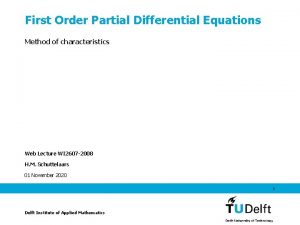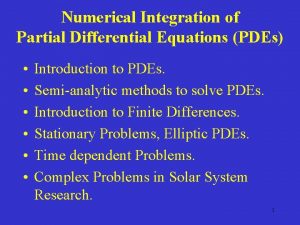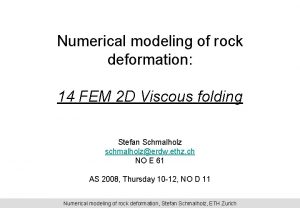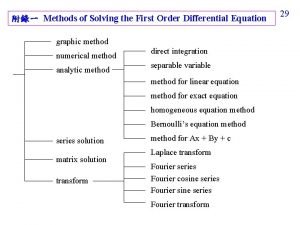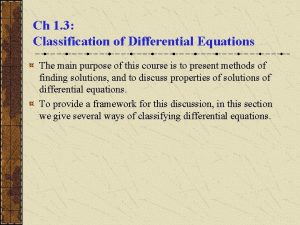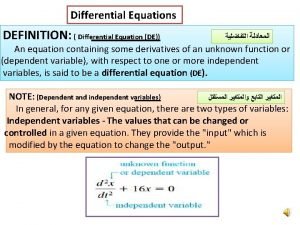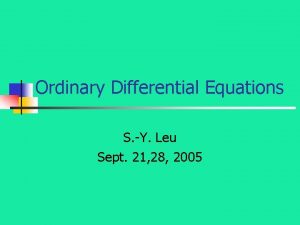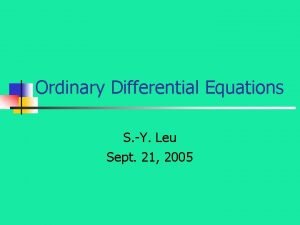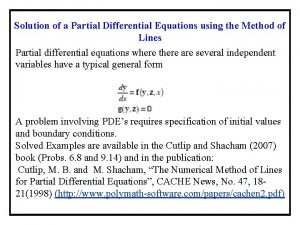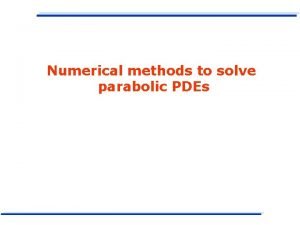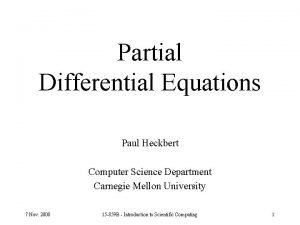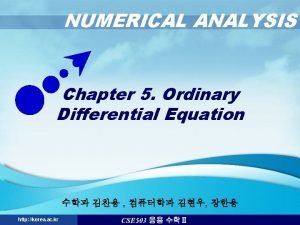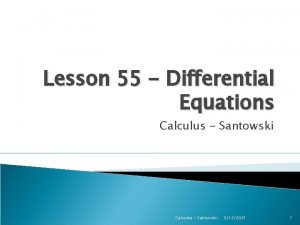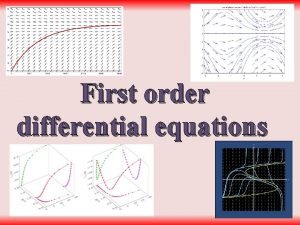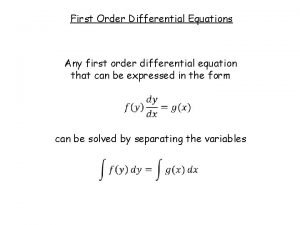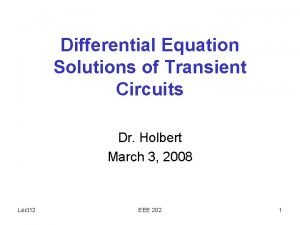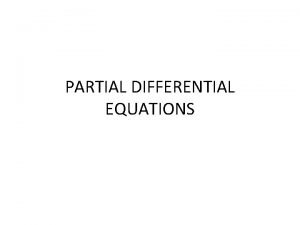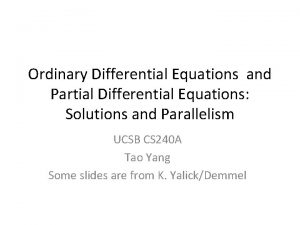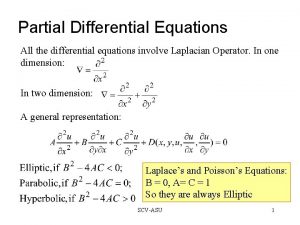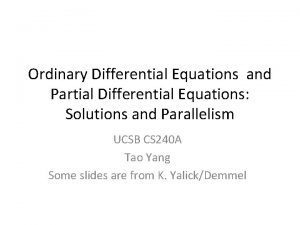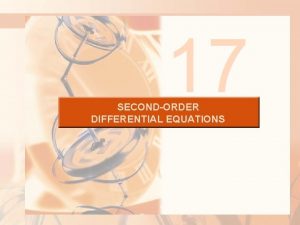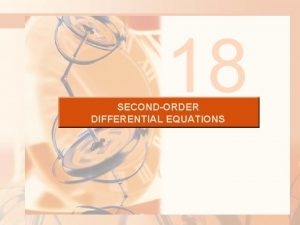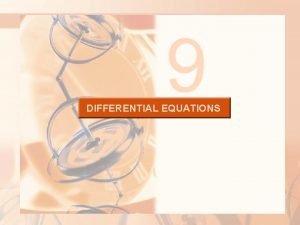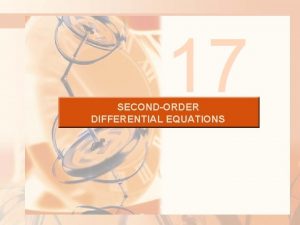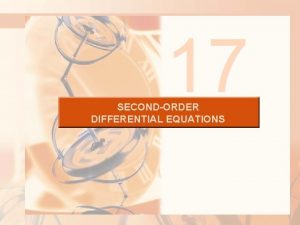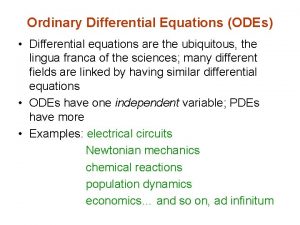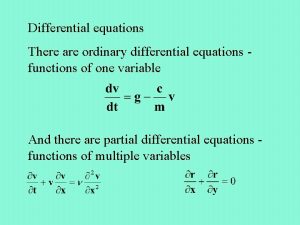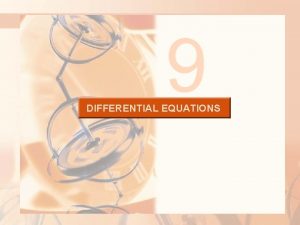Partial Differential Equations Definition One of the classical



















![Fourier Series • For a piecewise continuous function f on [-T, T], we have Fourier Series • For a piecewise continuous function f on [-T, T], we have](https://slidetodoc.com/presentation_image_h/d97fcb5201ea8404b34465665c628630/image-20.jpg)






- Slides: 26

Partial Differential Equations • Definition • One of the classical partial differential equation of mathematical physics is the equation describing the conduction of heat in a solid body (Originated in the 18 th century). And a modern one is the space vehicle reentry problem: Analysis of transfer and dissipation of heat generated by the friction with earth’s atmosphere.

For example: • Consider a straight bar with uniform crosssection and homogeneous material. We wish to develop a model for heat flow through the bar. • Let u(x, t) be the temperature on a cross section located at x and at time t. We shall follow some basic principles of physics: • A. The amount of heat per unit time flowing through a unit of cross-sectional area is proportional to with constant of proportionality k(x) called thermal conductivity of the material.

• B. Heat flow is always from points of higher temperature to points of lower temperature. • C. The amount of heat necessary to raise the temperature of an object of mass “m” by an amount u is a “c(x) m u”, where c(x) is known as the specific heat capacity of the material. • Thus to study the amount of heat H(x) flowing from left to right through a surface A of a cross section during the time interval t can then be given by the formula:

Likewise, at the point x + x, we have • Heat flowing from left to right across the plane during an time interval t is: • If on the interval [x, x+ x], during time t , additional heat sources were generated by, say, chemical reactions, heater, or electric currents, with energy density Q(x, t), then the total change in the heat E is given by the formula:

E = Heat entering A - Heat leaving B + Heat generated. • And taking into simplification the principle C above, E = c(x) m u, where m = (x) V. After dividing by ( x)( t), and taking the limits as x , and t 0, we get: • If we assume k, c, are constants, then the eq. Becomes:

Boundary and Initial conditions • Remark on boundary conditions and initial condition on u(x, t). • We thus obtain the mathematical model for the heat flow in a uniform rod without internal sources (p = 0) with homogeneous boundary conditions and initial temperature distribution f(x), the follolwing Initial Boundary Value Problem:

One Dimensional Heat Equation

The method of separation of variables • Introducing solution of the form • u(x, t) = X(x) T(t). • Substituting into the I. V. P, we obtain:

Boundary Conditions • Imply that we are looking for a non-trivial solution X(x), satisfying: • We shall consider 3 cases: • k = 0, k > 0 and k < 0.

• Case (i): k = 0. In this case we have • X(x) = 0, trivial solution • Case (ii): k > 0. Let k = 2, then the D. E gives X - 2 X = 0. The fundamental solution set is: { e x, e - x }. A general solution is given by: X(x) = c 1 e x + c 2 e - x • X(0) = 0 c 1 + c 2 = 0, and • X(L) = 0 c 1 e L + c 2 e - L = 0 , hence • c 1 (e 2 L -1) = 0 c 1 = 0 and so is c 2 = 0. • Again we have trivial solution X(x) 0.

Finally Case (iii) when k < 0. We again let k = - 2 , > 0. The D. E. becomes: X (x) + 2 X(x) = 0, the auxiliary equation is r 2 + 2 = 0, or r = ± i. The general solution: X(x) = c 1 e i x + c 2 e -i x or we prefer to write: X(x) = c 1 cos x + c 2 sin x. Now the boundary conditions X(0) = X(L) = 0 imply: • c 1 = 0 and c 2 sin L= 0, for this to happen, we need L = n , i. e. = n /L or k = - (n /L ) 2. • We set Xn(x) = an sin (n /L)x, n = 1, 2, 3, . . . • • •

Finally for T (t) - k. T(t) = 0, k = - 2. • We rewrite it as: T + 2 T = 0. Or T = - 2 T. We see the solutions are

u(x, t) = un(x, t), over all n. • More precisely, • This leads to the question of when it is possible to represent f(x) by the so called • Fourier sine series ? ?

Jean Baptiste Joseph Fourier (1768 - 1830) • Developed the equation for heat transmission and obtained solution under various boundary conditions (1800 - 1811). • Under Napoleon he went to Egypt as a soldier and worked with G. Monge as a cultural attache for the French army.

Example • Solve the following heat flow problem • Write 3 sin 2 x - 6 sin 5 x = cn sin (n /L)x, and comparing the coefficients, we see that c 2 = 3 , c 5 = -6, and cn = 0 for all other n. And we have u(x, t) = u 2(x, t) + u 5(x, t).

Wave Equation • In the study of vibrating string such as piano wire or guitar string.

Example: • f(x) = 6 sin 2 x + 9 sin 7 x - sin 10 x , and • g(x) = 11 sin 9 x - 14 sin 15 x. • The solution is of the form:

Reminder: • • TA’s Review session Date: July 17 (Tuesday, for all students) Time: 10 - 11: 40 am Room: 304 BH

Final Exam • • • Date: July 19 (Thursday) Time: 10: 30 - 12: 30 pm Room: LC-C 3 Covers: all materials I will have a review session on Wednesday
![Fourier Series For a piecewise continuous function f on T T we have Fourier Series • For a piecewise continuous function f on [-T, T], we have](https://slidetodoc.com/presentation_image_h/d97fcb5201ea8404b34465665c628630/image-20.jpg)
Fourier Series • For a piecewise continuous function f on [-T, T], we have the Fourier series for f:

Examples • Compute the Fourier series for

Convergence of Fourier Series • Pointwise Convegence • Theorem. If f and f are piecewise continuous on [ -T, T ], then for any x in (-T, T), we have • where the an, s and bn, s are given by the previous fomulas. It converges to the average value of the left and right hand limits of f(x). Remark on x = T, or -T.

Fourier Sine and Cosine series • Consider Even and Odd extensions; • Definition: Let f(x) be piecewise continuous on the interval [0, T]. The Fourier cosine series of f(x) on [0, T] is: • and the Fourier sine series is:

Consider the heat flow problem:

Solution • Since the boundary condition forces us to consider sine waves, we shall expand f(x) into its Fourier Sine Series with T = . Thus

With the solution
 Exact differential equation ppt
Exact differential equation ppt Characteristics method partial differential equations
Characteristics method partial differential equations Differential equations definition
Differential equations definition Integration of partial differential equation
Integration of partial differential equation Linear equations
Linear equations Partial differential equation
Partial differential equation Numerical methods for partial differential equations eth
Numerical methods for partial differential equations eth Separable partial differential equations
Separable partial differential equations Classification of differential equations
Classification of differential equations Definition of differential equation
Definition of differential equation Singular solution of ode
Singular solution of ode Nonlinear ordinary differential equations
Nonlinear ordinary differential equations Partial differential protection
Partial differential protection General solution of partial differential equation
General solution of partial differential equation The canonical form
The canonical form Parabolic partial differential equation
Parabolic partial differential equation The solution of partial differential equation
The solution of partial differential equation Differential equations projects
Differential equations projects Classification of pde examples
Classification of pde examples Cengage differential equations
Cengage differential equations Euler midpoint method
Euler midpoint method Carrying capacity equation calculus
Carrying capacity equation calculus Seperation of variables
Seperation of variables Solving 1st order differential equations
Solving 1st order differential equations First ode
First ode Cengage differential equations
Cengage differential equations Transient solution differential equations
Transient solution differential equations

